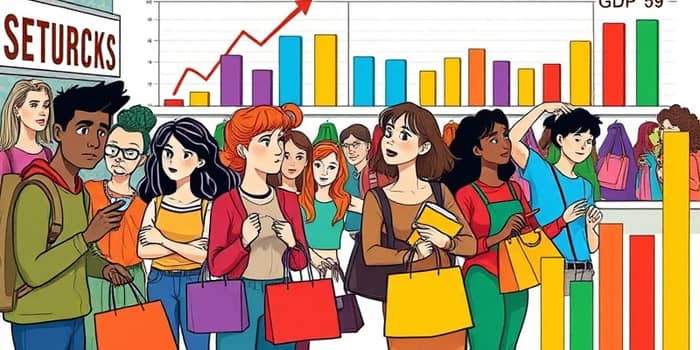
At first glance, the divergence between consumer sentiment and GDP growth may seem perplexing. One measure reflects the moods of millions, while the other tracks the value of goods and services produced across an entire economy. Yet in 2025, Americans’ feelings about the economy have fluctuated far more rapidly than GDP figures can capture.
GDP, or Gross Domestic Product, is the premier hard indicator of economic activity, measured quarterly and revised over time. It aggregates output, investment, government spending, and net exports into a single figure. In Q1 2025, U.S. GDP contracted at an annualized rate of 0.3%, primarily because of rising imports driven by tariff anticipation—not a sweeping downturn in domestic demand.
Meanwhile, real personal consumption expenditure (PCE), the largest component of GDP at nearly 70%, rose by 1.8% quarter-over-quarter. This consumer spending remains relatively resilient despite headline worries. Yet survey-based sentiment indexes have painted a different picture.
Data points like these underscore the paradox: sentiment indexes, released monthly, show swift swings, whereas GDP reflects a broader, slower-moving reality.
Several factors drive the rapid shifts in consumer mood, often ahead of or in contrast to economic fundamentals:
As a result, sentiment often leads GDP indicators, rising or falling based on immediate stimuli rather than accumulated economic momentum.
By design, GDP data arrives with a lag. First estimates for a quarter are released roughly a month after it ends, with subsequent revisions extending into the following months. This ensures accuracy but reduces timeliness.
Policymakers face a dilemma: should they act on real-time mood indicators or wait for hard data? Acting too late risks ineffective interventions; moving too early may address noise rather than signal.
Understanding the GDP lag helps in crafting responsive strategies. For instance, if consumer sentiment remains weak but PCE growth holds, central banks might resist immediate policy tightening, recognizing that sentiment rebounds could follow a soft patch in confidence.
Despite low sentiment readings, many households have found creative ways to maintain their spending power and well-being. Since 2019, roughly 80% of consumers report changing purchasing habits to cope with higher costs—efforts that, paradoxically, worsen their perceived hardship.
These adaptations highlight a deeper resilience: while sentiment metrics deteriorate, actual spending on necessities remains steady, and the labor market continues to absorb new entrants and reward workers with wage gains in certain sectors.
As we move deeper into 2025, the gap between consumer sentiment and GDP may widen or converge, depending on several factors:
• Evolving inflation dynamics. If price pressures ease further, sentiment could rebound quickly, aligning with strong PCE growth.
• Trade policy clarity. Reducing tariff uncertainty may stabilize mood swings.
• Media cycle moderation. Less polarized coverage could dampen knee-jerk reactions and smooth sentiment volatility.
For businesses and policymakers, the key is to monitor both hard data and consumer outlook. By combining monthly sentiment snapshots with quarterly GDP analyses, decision-makers can gain a holistic view—recognizing that feelings often run ahead of facts, but it is the facts that ultimately shape long-term outcomes.
References













